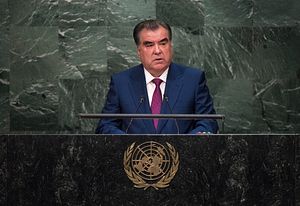On Sunday, nearly 3.5 million Tajiks showed up polls to vote “yes” on a referendum package comprising of 41 constitutional amendments. Turnout soared at 92 percent with 94.5 percent voting the amendments package in. Among the amendments was the abolition of term limits for the country’s first president (named Leader of the Nation just last year!) and a lowering of the age of eligibility to be president. There were also amendments banning Tajiks with dual-citizenship or those without a university degree from public office, a ban on political parties receiving money from foreigners, and, of course, a ban on religious and nationalist political parties.
Only 134,171 people–or just over 3 percent of those who showed up to vote–said nay.
This is, of course, the Tajik government’s official version. Asia-Plus cited the numbers above as coming from the Central Commission on Elections and Referenda (CCER), though TASS cites different numbers from the same source.
Nonetheless, while it is a lovely fiction of nearly unanimous love and support for President Emomali Rahmon, it is a fiction nonetheless.
Take, as anecdotal evidence contrary to the government’s narrative, Robin Forestier-Walker’s tweets from Dushanbe remarking on how light voting seemed or his pictures of empty polling stations. While CIS observers monitored the election, the OSCE did not. The head of the Russian monitoring mission and member of the Russian Central Election Commission, Sergey Sirotkin, told TASS that the referendum was fully in compliance with Tajikistan’s laws. “We are monitoring only the observance of legal procedures. In this respect, the referendum was held in full compliance with the laws,” he said. “It is their domestic affair. We assess only observance of procedural aspects.”
The government’s story is thin even when using its own numbers. Ahead of the vote, in a convenient explainer, the International Foundation for Electoral Systems (IFES) wrote that the CCER estimated “there are approximately 900,000 eligible voters currently residing abroad.” That is about 21 percent of the 4.2 million Tajiks the government says are eligible to vote. Ignoring, for the moment, the fact that the number of Tajik migrant workers in Russia is believed to be higher than official estimates, the government’s claim that voter turnout was 92 percent means most of the Tajiks abroad voted.
According to IFES, the Tajik government set up 38 polling stations in 29 countries. In Russia, there were to be “at least three voting locations.” Even if only half of Tajiks abroad voted in the referendum (say 450,000 of them) that would mean on average nearly 12,000 Tajiks voted at each of the 38 polling stations.
But there are not, as far as I am aware, pictures of queues of Tajiks abroad waiting to cross out no (as a “yes” vote necessitated crossing out the “no” option). Instead, there were several protests–in Turkey, Germany, Poland and elsewhere–in the days before the vote by Tajiks firmly opposed to the referendum.
Tajikistan’s decline–politically and economically–has been charted in these pixels and elsewhere over the past year and more. The referendum, sham that it is, will be held up by Dushanbe as proof of its legitimacy to the world.
Rahmon now can run–legally–for as many terms as he wishes (not that term limits stopped him before). He has also paved the way for his son to run for the presidency in 2020, should the elder Rahmon feel like retiring to his immunity and perpetual ability to interfere in government affairs (made law in the same law passed last year that gave Rahmon his Leader of the Nation title).

































